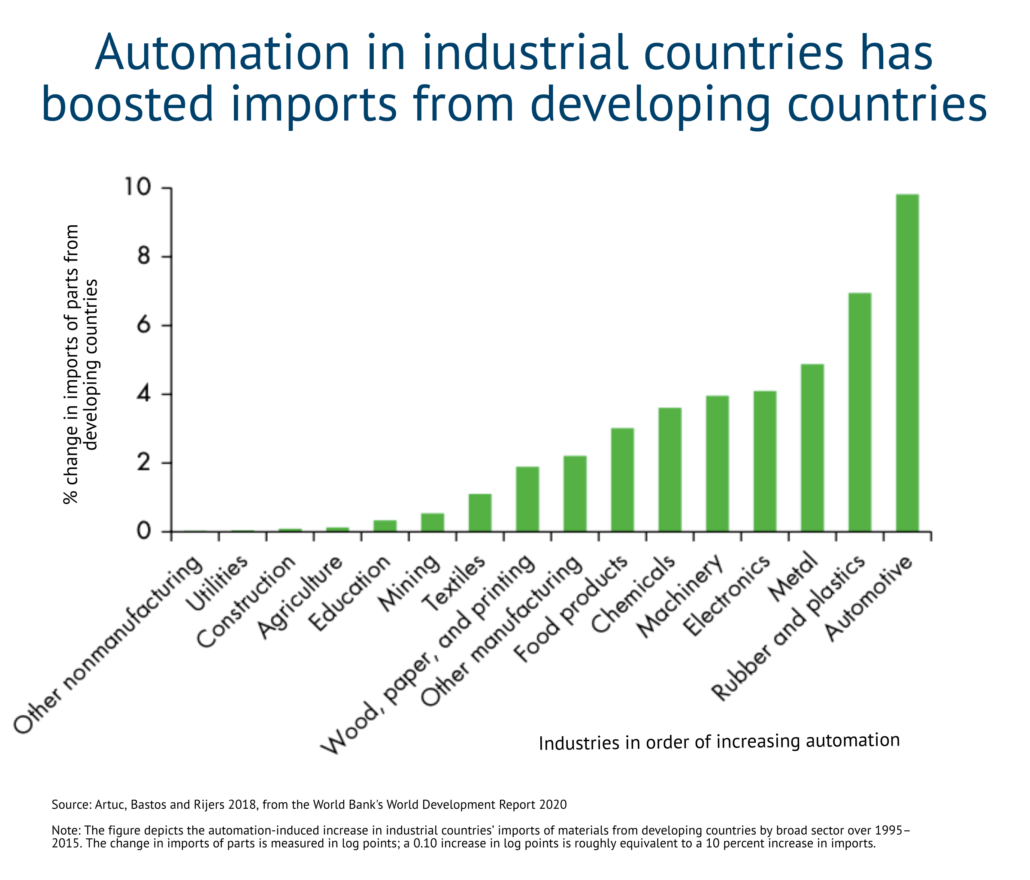Published 14 November 2019
Would automation cause lasting negative impact on trade? While many industry observers are sounding alarms, data and evidence don't support the hype.
The original version of this article was published in The Hill.
Alarm bells are ringing
Many industry observers are sounding alarms about the looming impact of automation, robots and 3D printing, which they fear will destroy jobs, disrupt value chains and maybe even reduce the need for international trade. Developing countries are particularly concerned because trade has been an avenue to economic development and growth for them. But a recent report released by the World Bank shows that the data and evidence don’t support the hype. Instead, automation, robots and 3D printing might actually increase trade as trade costs continue to fall.
Some business analysts have warned that automation and robots could disrupt and shorten global supply chains. The thinking behind the concern is that, if a computer can design it and a 3D printer can make it, then we won’t need to source it from countries abroad that have more abundant low-cost labor than we do. Instead, companies will drastically shorten their value chains, which could reduce international trade.
The anxieties have gotten the attention of development economists and developing countries. Trade and economic growth go hand-in-hand, both in economic theory and in practice. Multiple studies have shown that firms in developing countries that participate in global value chains outperform their local peers that solely focus on domestic markets. If robots eliminate the need for global value chains, this important avenue for economic development could be threatened.
Anxiety over automation may be overblown
Scare tactics about economic change are attractive because they get our attention. About 15 years ago, we saw headlines about “white collar outsourcing” (once attorneys were added to the list of jobs that could be moved offshore, the panic even spread into boardrooms). Some lawmakers called for restrictions on offshoring, and some of those calls are still alive today. But the mass exodus of white collar jobs did not occur.
The World Bank is a multilateral development agency that makes grants and loans to support capital projects and economic growth in the poorest countries. Anything that reduces the need for trade and global value chains would hit those developing countries hard, putting the automation concerns squarely on the World Bank’s radar.
In its annual World Development Report, the latest released on October 8, the World Bank does not take a definitive stance on the overall effects of automation, and it does not make any bold predictions. But it does make one thing clear: The anxiety over automation hindering trade is not supported by the data and evidence. In fact, the authors show that sectors with the largest increases in automation have also been those with the largest increases in trade. Yep, that’s right: We’re experiencing the opposite phenomenon to what so many are worried about.
Automation actually helping to expand trade
Specifically, the report shows that the percentage change in imports of parts from developing countries from 1995 to 2015 is higher in industries that are more automated. Agriculture and textiles are among the least-automated industries and have the smallest change. Metal, rubber and plastics, and automotive sectors have the highest rates of automation and the largest increases in trade.

Why? Because automation, like robotic assembly and 3D printing, leads to an expansion in output and demand for material inputs. Automation can also lead to the creation of new tasks. So while it brings labor market adjustment pains — like technology and progress always do — automation will not necessarily reduce trade or shorten global value chains.
Meanwhile, investments in digital technologies continue to lower the costs of coordinating across long distances. These lower trade costs are expected to promote trade and lead to a continued expansion of global value chains, particularly for developing countries.
The big picture
Here’s the big picture: Change is the one thing in the economy you can count on. Improvements in how we make things and advanced production technologies are likely to continue, and workers and firms that adapt and embrace these changes are likely to outperform those that do not. But a wide-sweeping elimination of trade and global value chains due to automation and robots? Don’t believe the hype.
© The Hinrich Foundation. See our website Terms and conditions for our copyright and reprint policy. All statements of fact and the views, conclusions and recommendations expressed in this publication are the sole responsibility of the author(s).




